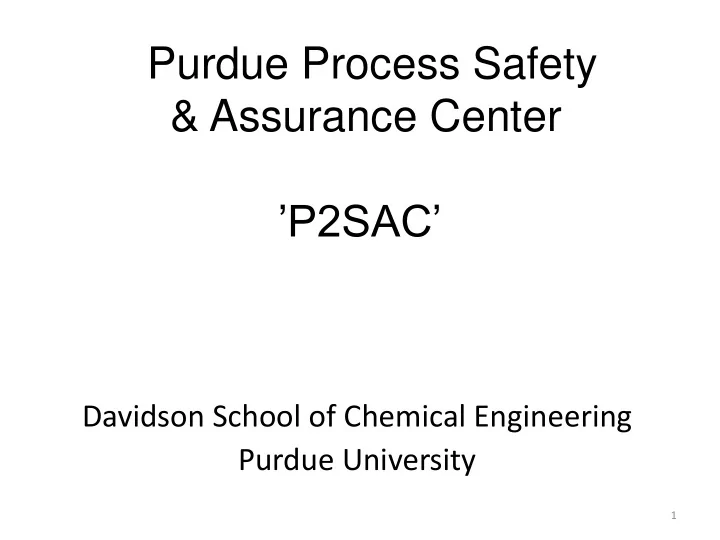

Purdue Process Safety & Assurance Center ’P2SAC’ Davidson School of Chemical Engineering Purdue University 1
Bhopal, India – 1984; +2,000 fatalities Imperial Sugar, Georgia – 2008; 14 fatalities 2 Texas Tech University; Chem Lab – 2010 BP Texas City, 2005; 15 fatalities
P2SAC Formed in 2014 • A challenging quantitative / technical discipline; scope not widely recognized • Conduct process safety related research focusing on fundamental science • Teach process safety courses and instill Process Safety Management (PSM) considerations in core capstone design projects (~190 UG and Grad students enrolled Fall ‘17) • Engage UG & Prof MS students in process safety research • Source of expertise for industry and other stakeholders regarding process safety related standards & best practices • Focus on oil & gas industry, chemicals, pharmaceuticals, agriculture, and technology including consumer products and manufacturing • Research projects solicited from industry sponsors, as well as other stakeholders such as academia & government labs 3 • Enhance education experience of all Purdue Chem Eng graduates
P2SAC ‘17 Research Program PhD MS Projects • Re-examine current basis for gas and fire detector placement • Compilation of thermal hazard safety data for amide coupling reagents - COMPLETE • Optimal placement of gas detectors in process facilities: bringing optimization- • Validate large scale consequence modeling based gas detector placement into practice with Middle East propane release - COMPLETE • Prevention through catalyst design for applications in the petrochemical UG Research industry • Conduct a process safety related • Robust model-based control for safe benchmarking survey of the pharmaceutical manufacturing pharmaceutical industry, including data base of incidents • Advanced separation techniques for producing rare earth elements and other chemicals from coal fly ash • Frequency & cause of LNG metallurgy failures • Computational analysis of drop coalescence in emulsions to reduce • Risk & Reliability of Aged Natural Gas & retention times in oil-water separators 4 Product Pipelines
Multiple Chemical Engineering Faculty Engaged in Process Safety Related Research PhD • Re-examine current basis for gas and fire detector placement • Optimal placement of gas detectors in process facilities: bringing optimization- based gas detector placement into practice • Prevention through catalyst design for applications in the petrochemical industry • Robust model-based control for safe pharmaceutical manufacturing • Advanced separation techniques for producing rare earth elements and other chemicals from coal fly ash • Computational analysis of drop coalescence in emulsions to reduce 5 retention times in oil-water separators
CHEN 420 / 597- Chemical Process Safety – core UG course Personnel vs. Process Safety & Metrics Applicable regulations: OSHA PSM, EPA RMP, etc Source Term Modeling Toxicants & Industrial Hygiene T-2 Laboratories, FL – ’09; 4 fatalities Toxic/Flammable Gas Release Dispersion Modeling Fire & Explosion Protection Chemical Reactivity Relief System Design Hazards Identification (HAZOP, ..) Risk Assessment (Matrix, QRA, ..) Accident Investigations 6
P2SAC Fall Conference - Dec 5, 2017 8:00‐8:15 Prof Osman Basaran: Welcome, status of P2SAC and agenda 8:15‐8:45 Prof Ray Mentzer: P2SAC vision, UG & MS research, core process safety course 8:45‐9:25 Prof Carl Laird: Systems engineering and optimization techniques for improved safety and security of critical infrastructure; b) Gas detector placement in petrochemical and chemical facilities 9:25‐10:05 Prof Raj Gounder: Prevention through catalyst design for applications in the petrochem industry 10:05‐10:20 Refreshment break 10:20‐10:50 Prof Kingsly Ambrose (Ag Eng): Dust Explosions: preventive precautions 10:50 – 11:30 George Harriott (Air Products): Leak detection on gas pipelines 11:30‐12:00 Prof Brett Savoie: Using high throughput simulations to predict safety figures of merit for organic compounds 12:00‐12:50 Catered lunch 12:50 – 1:30 Prof Zoltan Nagy: Robust fault-tolerant control for continuous direct compaction & runaway reactions and overview of research in pharma engineering 1:30-2:00 Stan Kolis (Eli Lilly): Early phase thermal hazard assessments in the pharma industry 2:00‐2:40 Prasad Goteti (Honeywell): SIL rated communication protocols 2:40‐3:10 Jonathan Bach (NIOSH): Prevention through Design 3:10‐3:25 Refreshment break 3:25 – 3:55 Marabeth Holsinger (Dow): Calorimetric determination of the oxidation of solids and organics adsorbed on solids 3:55-4:25 Prof Linda Wang: Economical & environmentally sound technology for producing rare earth elements and others from coal fly ash 4:25‐4:55 Prof Letian Dou: Lead-containing halide perovskites nonmaterial for energy harvesting and related safety issues 4:55 – 5:25 Prof Osman Basaran: Drop and bubble coalescence, thin films, and flow assurance 5:25 – 5:35 Short Break 7 5:35‐6:15 Open discussion, industry needs and future center projects; followed by dinner at 7:00
Current Sponsors Advisory Board also includes Air Products & National Institute for Occupational Safety & Health (NIOSH) Typical Sponsor agreement is $25k / year for 3 years Room for More … long list of potential research projects & open to suggested projects from Sponsors 8
Recommend
More recommend